Nursing Interventions for Respite Care: A Case Study of Mrs. Jessica George
VerifiedAdded on 2023/01/13
|11
|3163
|57
AI Summary
This assignment focuses on the nursing interventions for Mrs. Jessica George, a 79-year old lady suffering from Parkinson's disease, during her respite care. It discusses the primary diagnosis, nursing problems, nursing management, and discharge planning. The assignment also highlights the role of registered nurses in medication management and the importance of a multidisciplinary approach.
Contribute Materials
Your contribution can guide someone’s learning journey. Share your
documents today.
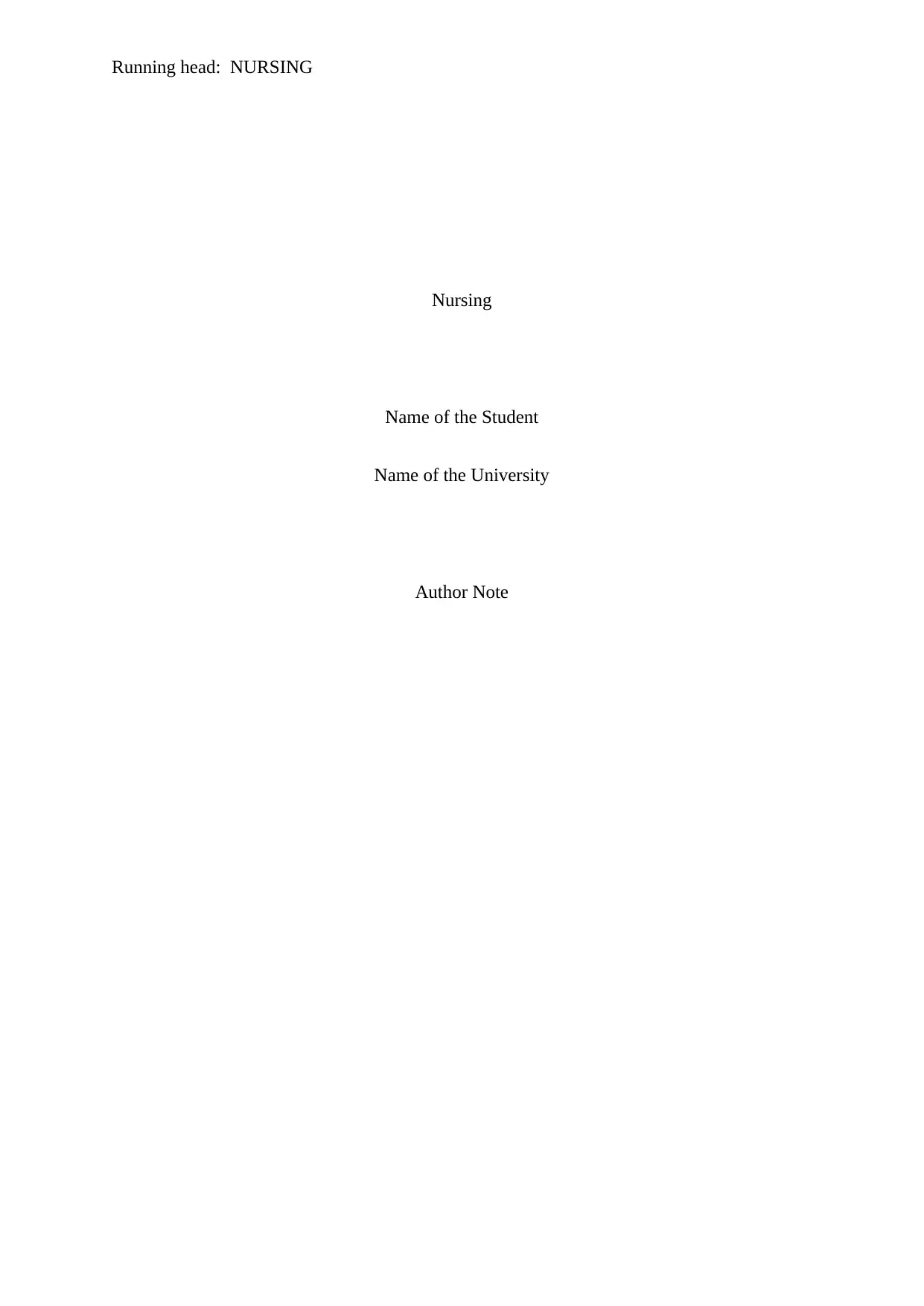
Running head: NURSING
Nursing
Name of the Student
Name of the University
Author Note
Nursing
Name of the Student
Name of the University
Author Note
Secure Best Marks with AI Grader
Need help grading? Try our AI Grader for instant feedback on your assignments.
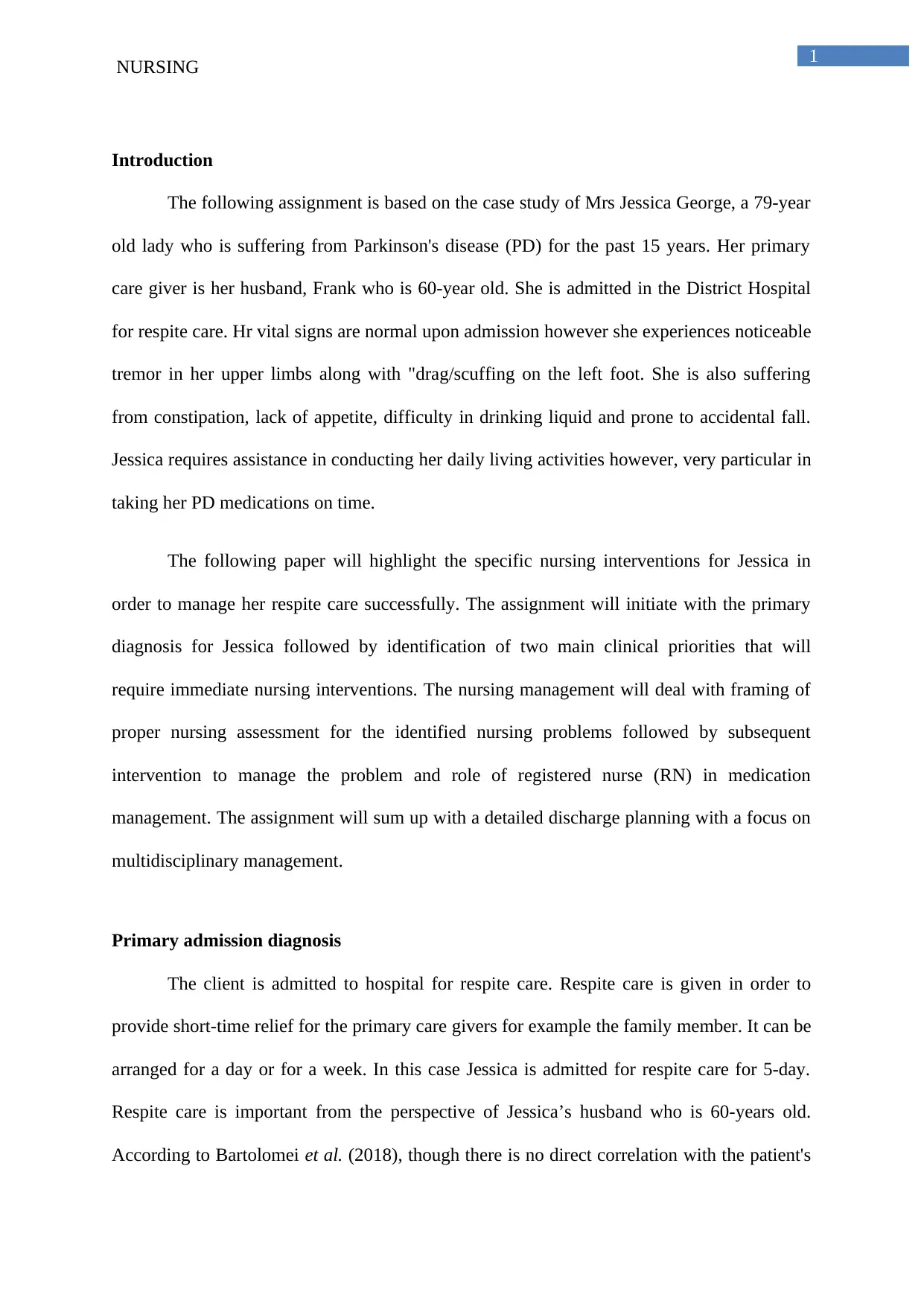
1
NURSING
Introduction
The following assignment is based on the case study of Mrs Jessica George, a 79-year
old lady who is suffering from Parkinson's disease (PD) for the past 15 years. Her primary
care giver is her husband, Frank who is 60-year old. She is admitted in the District Hospital
for respite care. Hr vital signs are normal upon admission however she experiences noticeable
tremor in her upper limbs along with "drag/scuffing on the left foot. She is also suffering
from constipation, lack of appetite, difficulty in drinking liquid and prone to accidental fall.
Jessica requires assistance in conducting her daily living activities however, very particular in
taking her PD medications on time.
The following paper will highlight the specific nursing interventions for Jessica in
order to manage her respite care successfully. The assignment will initiate with the primary
diagnosis for Jessica followed by identification of two main clinical priorities that will
require immediate nursing interventions. The nursing management will deal with framing of
proper nursing assessment for the identified nursing problems followed by subsequent
intervention to manage the problem and role of registered nurse (RN) in medication
management. The assignment will sum up with a detailed discharge planning with a focus on
multidisciplinary management.
Primary admission diagnosis
The client is admitted to hospital for respite care. Respite care is given in order to
provide short-time relief for the primary care givers for example the family member. It can be
arranged for a day or for a week. In this case Jessica is admitted for respite care for 5-day.
Respite care is important from the perspective of Jessica’s husband who is 60-years old.
According to Bartolomei et al. (2018), though there is no direct correlation with the patient's
NURSING
Introduction
The following assignment is based on the case study of Mrs Jessica George, a 79-year
old lady who is suffering from Parkinson's disease (PD) for the past 15 years. Her primary
care giver is her husband, Frank who is 60-year old. She is admitted in the District Hospital
for respite care. Hr vital signs are normal upon admission however she experiences noticeable
tremor in her upper limbs along with "drag/scuffing on the left foot. She is also suffering
from constipation, lack of appetite, difficulty in drinking liquid and prone to accidental fall.
Jessica requires assistance in conducting her daily living activities however, very particular in
taking her PD medications on time.
The following paper will highlight the specific nursing interventions for Jessica in
order to manage her respite care successfully. The assignment will initiate with the primary
diagnosis for Jessica followed by identification of two main clinical priorities that will
require immediate nursing interventions. The nursing management will deal with framing of
proper nursing assessment for the identified nursing problems followed by subsequent
intervention to manage the problem and role of registered nurse (RN) in medication
management. The assignment will sum up with a detailed discharge planning with a focus on
multidisciplinary management.
Primary admission diagnosis
The client is admitted to hospital for respite care. Respite care is given in order to
provide short-time relief for the primary care givers for example the family member. It can be
arranged for a day or for a week. In this case Jessica is admitted for respite care for 5-day.
Respite care is important from the perspective of Jessica’s husband who is 60-years old.
According to Bartolomei et al. (2018), though there is no direct correlation with the patient's
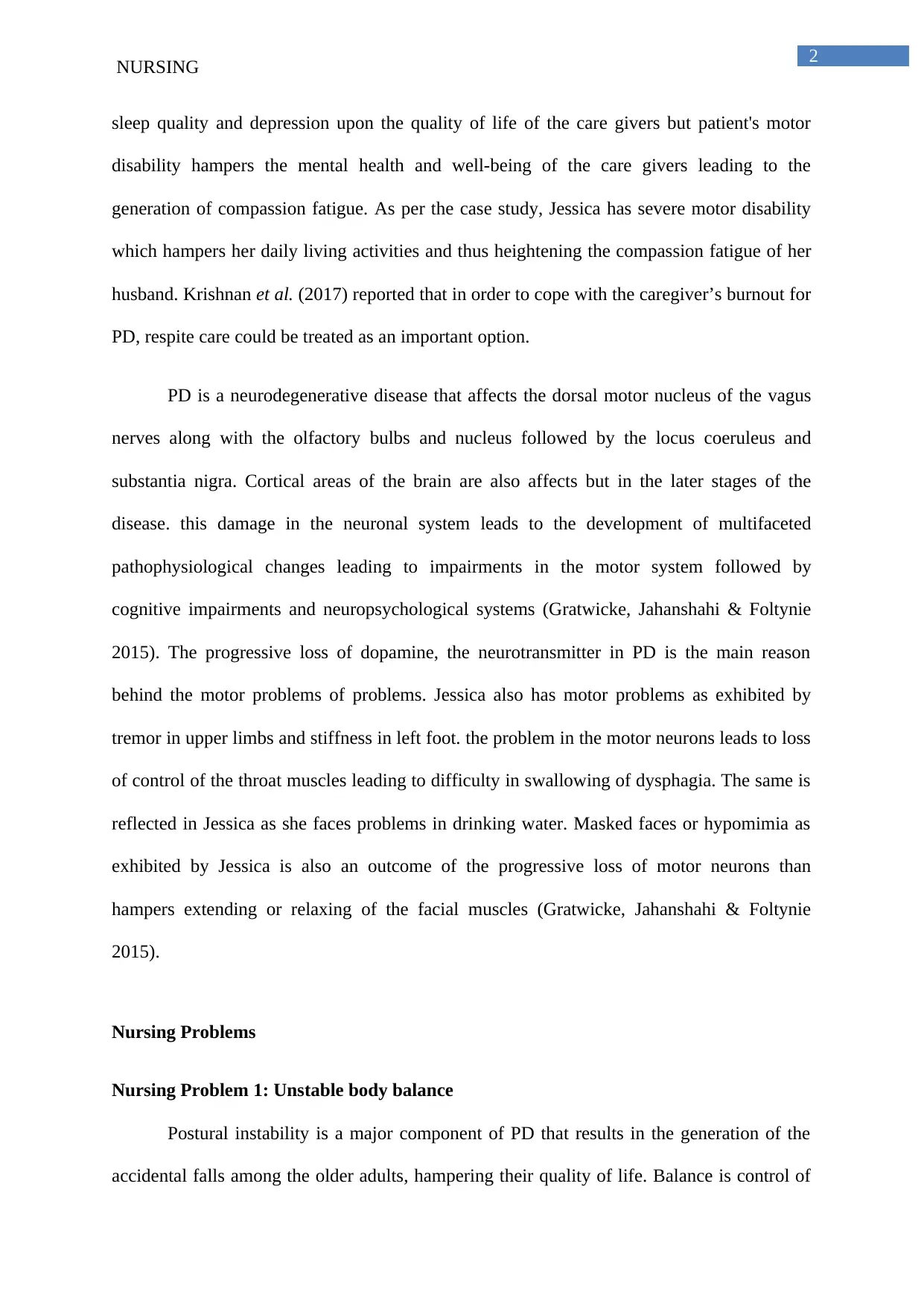
2
NURSING
sleep quality and depression upon the quality of life of the care givers but patient's motor
disability hampers the mental health and well-being of the care givers leading to the
generation of compassion fatigue. As per the case study, Jessica has severe motor disability
which hampers her daily living activities and thus heightening the compassion fatigue of her
husband. Krishnan et al. (2017) reported that in order to cope with the caregiver’s burnout for
PD, respite care could be treated as an important option.
PD is a neurodegenerative disease that affects the dorsal motor nucleus of the vagus
nerves along with the olfactory bulbs and nucleus followed by the locus coeruleus and
substantia nigra. Cortical areas of the brain are also affects but in the later stages of the
disease. this damage in the neuronal system leads to the development of multifaceted
pathophysiological changes leading to impairments in the motor system followed by
cognitive impairments and neuropsychological systems (Gratwicke, Jahanshahi & Foltynie
2015). The progressive loss of dopamine, the neurotransmitter in PD is the main reason
behind the motor problems of problems. Jessica also has motor problems as exhibited by
tremor in upper limbs and stiffness in left foot. the problem in the motor neurons leads to loss
of control of the throat muscles leading to difficulty in swallowing of dysphagia. The same is
reflected in Jessica as she faces problems in drinking water. Masked faces or hypomimia as
exhibited by Jessica is also an outcome of the progressive loss of motor neurons than
hampers extending or relaxing of the facial muscles (Gratwicke, Jahanshahi & Foltynie
2015).
Nursing Problems
Nursing Problem 1: Unstable body balance
Postural instability is a major component of PD that results in the generation of the
accidental falls among the older adults, hampering their quality of life. Balance is control of
NURSING
sleep quality and depression upon the quality of life of the care givers but patient's motor
disability hampers the mental health and well-being of the care givers leading to the
generation of compassion fatigue. As per the case study, Jessica has severe motor disability
which hampers her daily living activities and thus heightening the compassion fatigue of her
husband. Krishnan et al. (2017) reported that in order to cope with the caregiver’s burnout for
PD, respite care could be treated as an important option.
PD is a neurodegenerative disease that affects the dorsal motor nucleus of the vagus
nerves along with the olfactory bulbs and nucleus followed by the locus coeruleus and
substantia nigra. Cortical areas of the brain are also affects but in the later stages of the
disease. this damage in the neuronal system leads to the development of multifaceted
pathophysiological changes leading to impairments in the motor system followed by
cognitive impairments and neuropsychological systems (Gratwicke, Jahanshahi & Foltynie
2015). The progressive loss of dopamine, the neurotransmitter in PD is the main reason
behind the motor problems of problems. Jessica also has motor problems as exhibited by
tremor in upper limbs and stiffness in left foot. the problem in the motor neurons leads to loss
of control of the throat muscles leading to difficulty in swallowing of dysphagia. The same is
reflected in Jessica as she faces problems in drinking water. Masked faces or hypomimia as
exhibited by Jessica is also an outcome of the progressive loss of motor neurons than
hampers extending or relaxing of the facial muscles (Gratwicke, Jahanshahi & Foltynie
2015).
Nursing Problems
Nursing Problem 1: Unstable body balance
Postural instability is a major component of PD that results in the generation of the
accidental falls among the older adults, hampering their quality of life. Balance is control of
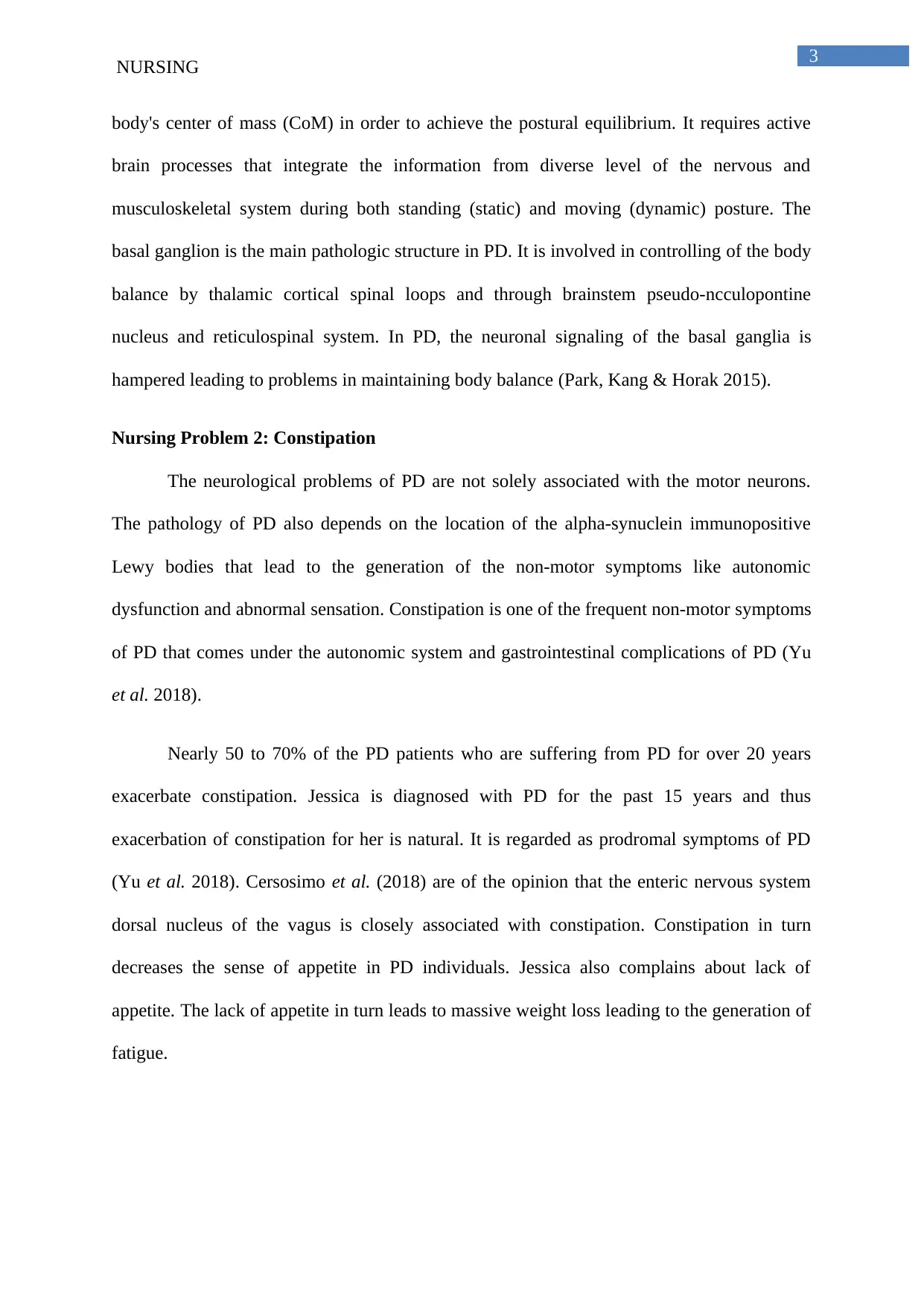
3
NURSING
body's center of mass (CoM) in order to achieve the postural equilibrium. It requires active
brain processes that integrate the information from diverse level of the nervous and
musculoskeletal system during both standing (static) and moving (dynamic) posture. The
basal ganglion is the main pathologic structure in PD. It is involved in controlling of the body
balance by thalamic cortical spinal loops and through brainstem pseudo-ncculopontine
nucleus and reticulospinal system. In PD, the neuronal signaling of the basal ganglia is
hampered leading to problems in maintaining body balance (Park, Kang & Horak 2015).
Nursing Problem 2: Constipation
The neurological problems of PD are not solely associated with the motor neurons.
The pathology of PD also depends on the location of the alpha-synuclein immunopositive
Lewy bodies that lead to the generation of the non-motor symptoms like autonomic
dysfunction and abnormal sensation. Constipation is one of the frequent non-motor symptoms
of PD that comes under the autonomic system and gastrointestinal complications of PD (Yu
et al. 2018).
Nearly 50 to 70% of the PD patients who are suffering from PD for over 20 years
exacerbate constipation. Jessica is diagnosed with PD for the past 15 years and thus
exacerbation of constipation for her is natural. It is regarded as prodromal symptoms of PD
(Yu et al. 2018). Cersosimo et al. (2018) are of the opinion that the enteric nervous system
dorsal nucleus of the vagus is closely associated with constipation. Constipation in turn
decreases the sense of appetite in PD individuals. Jessica also complains about lack of
appetite. The lack of appetite in turn leads to massive weight loss leading to the generation of
fatigue.
NURSING
body's center of mass (CoM) in order to achieve the postural equilibrium. It requires active
brain processes that integrate the information from diverse level of the nervous and
musculoskeletal system during both standing (static) and moving (dynamic) posture. The
basal ganglion is the main pathologic structure in PD. It is involved in controlling of the body
balance by thalamic cortical spinal loops and through brainstem pseudo-ncculopontine
nucleus and reticulospinal system. In PD, the neuronal signaling of the basal ganglia is
hampered leading to problems in maintaining body balance (Park, Kang & Horak 2015).
Nursing Problem 2: Constipation
The neurological problems of PD are not solely associated with the motor neurons.
The pathology of PD also depends on the location of the alpha-synuclein immunopositive
Lewy bodies that lead to the generation of the non-motor symptoms like autonomic
dysfunction and abnormal sensation. Constipation is one of the frequent non-motor symptoms
of PD that comes under the autonomic system and gastrointestinal complications of PD (Yu
et al. 2018).
Nearly 50 to 70% of the PD patients who are suffering from PD for over 20 years
exacerbate constipation. Jessica is diagnosed with PD for the past 15 years and thus
exacerbation of constipation for her is natural. It is regarded as prodromal symptoms of PD
(Yu et al. 2018). Cersosimo et al. (2018) are of the opinion that the enteric nervous system
dorsal nucleus of the vagus is closely associated with constipation. Constipation in turn
decreases the sense of appetite in PD individuals. Jessica also complains about lack of
appetite. The lack of appetite in turn leads to massive weight loss leading to the generation of
fatigue.
Secure Best Marks with AI Grader
Need help grading? Try our AI Grader for instant feedback on your assignments.
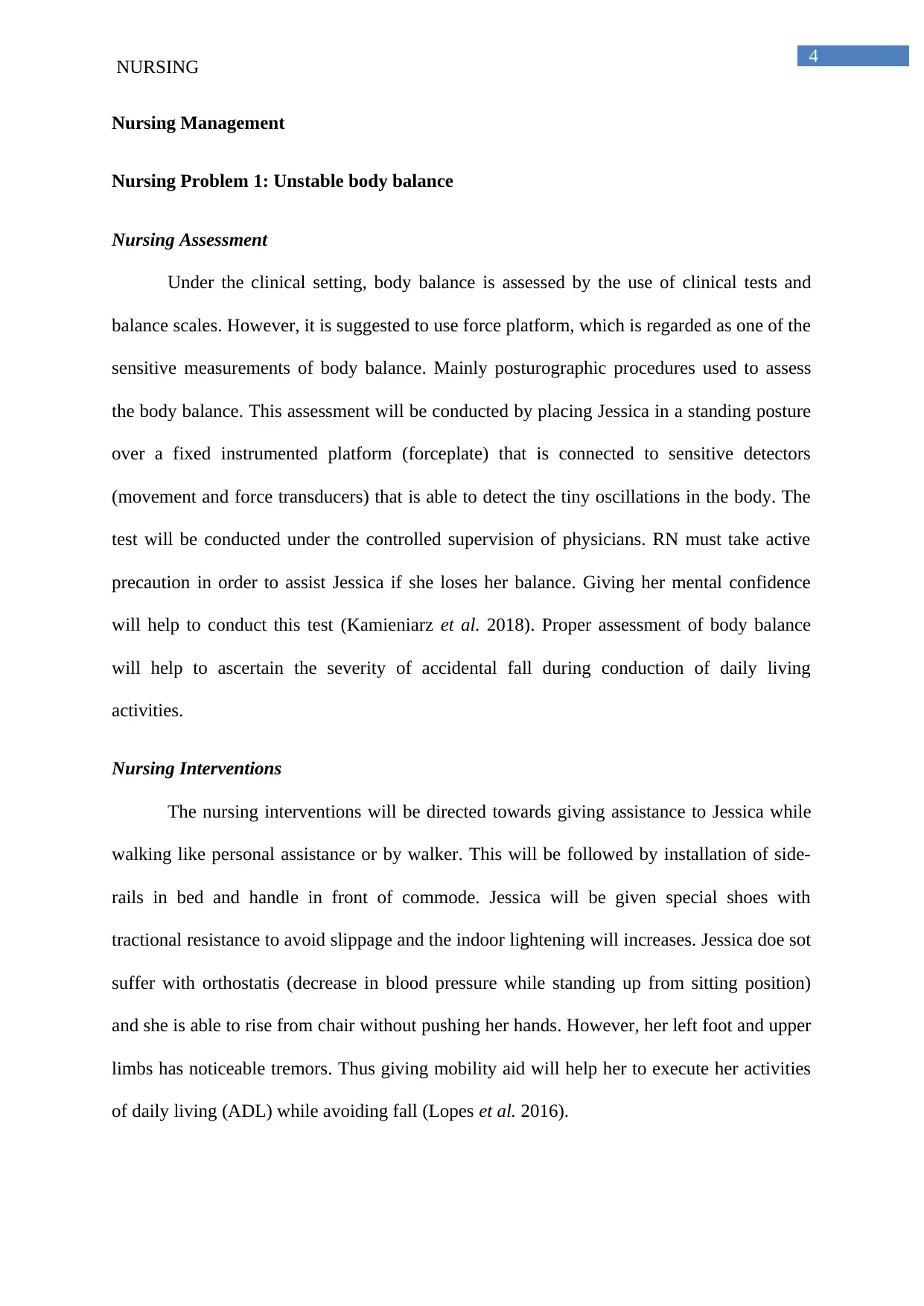
4
NURSING
Nursing Management
Nursing Problem 1: Unstable body balance
Nursing Assessment
Under the clinical setting, body balance is assessed by the use of clinical tests and
balance scales. However, it is suggested to use force platform, which is regarded as one of the
sensitive measurements of body balance. Mainly posturographic procedures used to assess
the body balance. This assessment will be conducted by placing Jessica in a standing posture
over a fixed instrumented platform (forceplate) that is connected to sensitive detectors
(movement and force transducers) that is able to detect the tiny oscillations in the body. The
test will be conducted under the controlled supervision of physicians. RN must take active
precaution in order to assist Jessica if she loses her balance. Giving her mental confidence
will help to conduct this test (Kamieniarz et al. 2018). Proper assessment of body balance
will help to ascertain the severity of accidental fall during conduction of daily living
activities.
Nursing Interventions
The nursing interventions will be directed towards giving assistance to Jessica while
walking like personal assistance or by walker. This will be followed by installation of side-
rails in bed and handle in front of commode. Jessica will be given special shoes with
tractional resistance to avoid slippage and the indoor lightening will increases. Jessica doe sot
suffer with orthostatis (decrease in blood pressure while standing up from sitting position)
and she is able to rise from chair without pushing her hands. However, her left foot and upper
limbs has noticeable tremors. Thus giving mobility aid will help her to execute her activities
of daily living (ADL) while avoiding fall (Lopes et al. 2016).
NURSING
Nursing Management
Nursing Problem 1: Unstable body balance
Nursing Assessment
Under the clinical setting, body balance is assessed by the use of clinical tests and
balance scales. However, it is suggested to use force platform, which is regarded as one of the
sensitive measurements of body balance. Mainly posturographic procedures used to assess
the body balance. This assessment will be conducted by placing Jessica in a standing posture
over a fixed instrumented platform (forceplate) that is connected to sensitive detectors
(movement and force transducers) that is able to detect the tiny oscillations in the body. The
test will be conducted under the controlled supervision of physicians. RN must take active
precaution in order to assist Jessica if she loses her balance. Giving her mental confidence
will help to conduct this test (Kamieniarz et al. 2018). Proper assessment of body balance
will help to ascertain the severity of accidental fall during conduction of daily living
activities.
Nursing Interventions
The nursing interventions will be directed towards giving assistance to Jessica while
walking like personal assistance or by walker. This will be followed by installation of side-
rails in bed and handle in front of commode. Jessica will be given special shoes with
tractional resistance to avoid slippage and the indoor lightening will increases. Jessica doe sot
suffer with orthostatis (decrease in blood pressure while standing up from sitting position)
and she is able to rise from chair without pushing her hands. However, her left foot and upper
limbs has noticeable tremors. Thus giving mobility aid will help her to execute her activities
of daily living (ADL) while avoiding fall (Lopes et al. 2016).
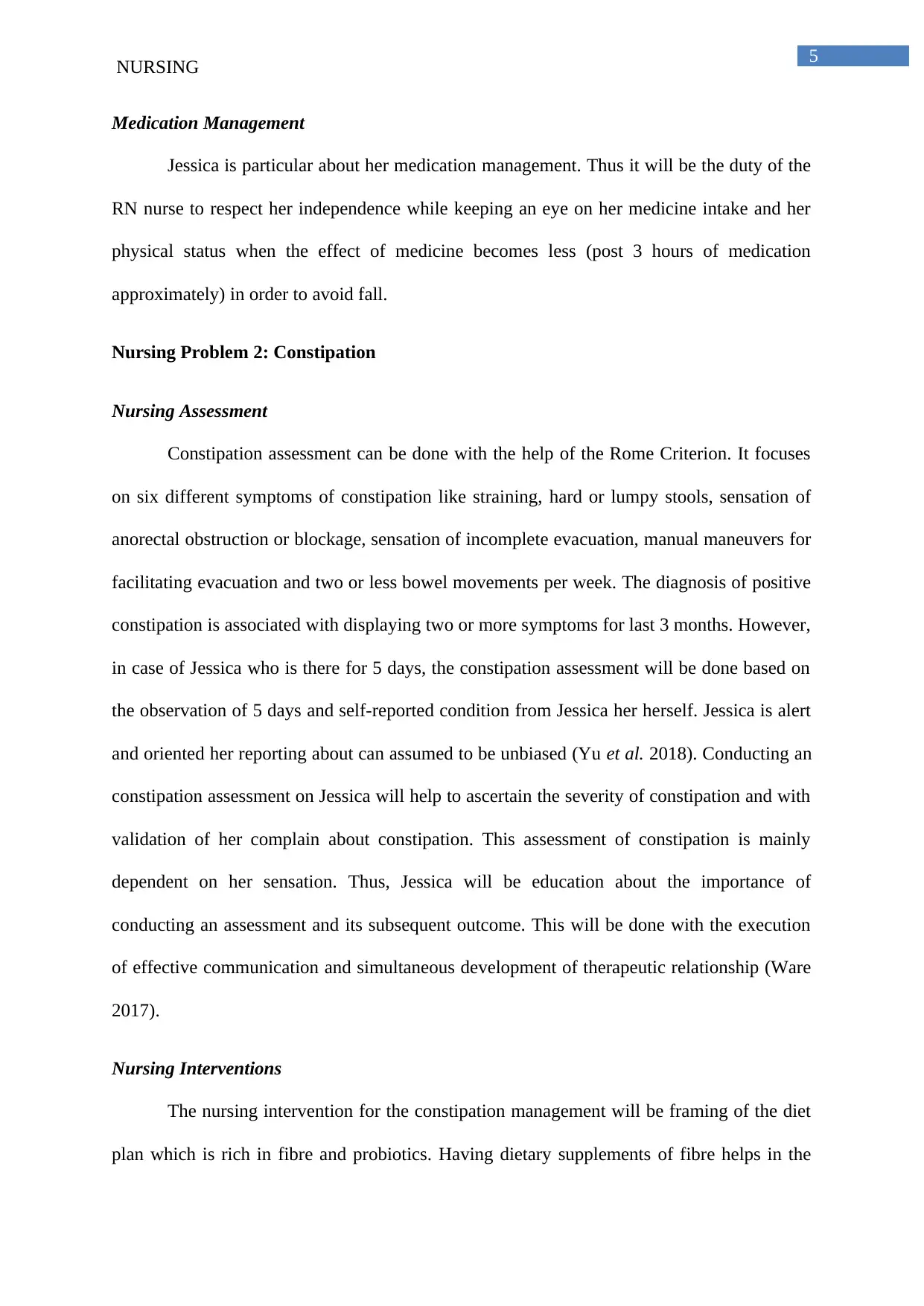
5
NURSING
Medication Management
Jessica is particular about her medication management. Thus it will be the duty of the
RN nurse to respect her independence while keeping an eye on her medicine intake and her
physical status when the effect of medicine becomes less (post 3 hours of medication
approximately) in order to avoid fall.
Nursing Problem 2: Constipation
Nursing Assessment
Constipation assessment can be done with the help of the Rome Criterion. It focuses
on six different symptoms of constipation like straining, hard or lumpy stools, sensation of
anorectal obstruction or blockage, sensation of incomplete evacuation, manual maneuvers for
facilitating evacuation and two or less bowel movements per week. The diagnosis of positive
constipation is associated with displaying two or more symptoms for last 3 months. However,
in case of Jessica who is there for 5 days, the constipation assessment will be done based on
the observation of 5 days and self-reported condition from Jessica her herself. Jessica is alert
and oriented her reporting about can assumed to be unbiased (Yu et al. 2018). Conducting an
constipation assessment on Jessica will help to ascertain the severity of constipation and with
validation of her complain about constipation. This assessment of constipation is mainly
dependent on her sensation. Thus, Jessica will be education about the importance of
conducting an assessment and its subsequent outcome. This will be done with the execution
of effective communication and simultaneous development of therapeutic relationship (Ware
2017).
Nursing Interventions
The nursing intervention for the constipation management will be framing of the diet
plan which is rich in fibre and probiotics. Having dietary supplements of fibre helps in the
NURSING
Medication Management
Jessica is particular about her medication management. Thus it will be the duty of the
RN nurse to respect her independence while keeping an eye on her medicine intake and her
physical status when the effect of medicine becomes less (post 3 hours of medication
approximately) in order to avoid fall.
Nursing Problem 2: Constipation
Nursing Assessment
Constipation assessment can be done with the help of the Rome Criterion. It focuses
on six different symptoms of constipation like straining, hard or lumpy stools, sensation of
anorectal obstruction or blockage, sensation of incomplete evacuation, manual maneuvers for
facilitating evacuation and two or less bowel movements per week. The diagnosis of positive
constipation is associated with displaying two or more symptoms for last 3 months. However,
in case of Jessica who is there for 5 days, the constipation assessment will be done based on
the observation of 5 days and self-reported condition from Jessica her herself. Jessica is alert
and oriented her reporting about can assumed to be unbiased (Yu et al. 2018). Conducting an
constipation assessment on Jessica will help to ascertain the severity of constipation and with
validation of her complain about constipation. This assessment of constipation is mainly
dependent on her sensation. Thus, Jessica will be education about the importance of
conducting an assessment and its subsequent outcome. This will be done with the execution
of effective communication and simultaneous development of therapeutic relationship (Ware
2017).
Nursing Interventions
The nursing intervention for the constipation management will be framing of the diet
plan which is rich in fibre and probiotics. Having dietary supplements of fibre helps in the

6
NURSING
significant reduction of constipation which increasing the number of the stool frequency. The
fibre diet for 2 months helps to reduce the severity of constipation. The probiotic diet on the
other hand mainly constitutes of consumption of fermented milk of Lactobacillus casei
shirota for at least 2 weeks in order to experience notable change in constipation. The change
is experienced in reduction in bloating, abdominal pain and sensation of incomplete empting
(Yu et al. 2018). However, before commencing probiotic diet it should be cross-checked
whether Jessica has lactose-intolerant.
Medication Management
The medication management for the constipation will include administration of
lactulose solution in order to ease the passage of stool through rectum. The dosage of
lactulose must be determined under the presence of physicians in order to avoid medication
error. Since Jessica has dysphasia, feeding of milk as a part of probiotic diet or lactulose tonic
must be done while sitting in an upright position (90 degree) while avoiding speech while
drinking. After the milk is swallowed, it is the duty of the nurse to turn the head down,
tucking towards the chin to chest and bending the body forward in order to prevent the
changes of vomiting or coughing (Tosin et al. 2016).
Discharge Planning
According to Doenges, Moorhouse and Murr (2016) the main issues that must be
taken under consideration under the discharge planning include documentation of the mode
of transport. For Jessica, the main mode of transport will be car. Since her husband is also an
older adult, it would be wise for the district hospital to arrange a hospital car to drive them
back to their home in rural area of SA and then comes accompanying the patient. Jessica and
her husband will be accompanied with a residential care nurse in order to make the necessary
arrangements at home to prevent accidental fall like indoor lights, the furniture arrangements
NURSING
significant reduction of constipation which increasing the number of the stool frequency. The
fibre diet for 2 months helps to reduce the severity of constipation. The probiotic diet on the
other hand mainly constitutes of consumption of fermented milk of Lactobacillus casei
shirota for at least 2 weeks in order to experience notable change in constipation. The change
is experienced in reduction in bloating, abdominal pain and sensation of incomplete empting
(Yu et al. 2018). However, before commencing probiotic diet it should be cross-checked
whether Jessica has lactose-intolerant.
Medication Management
The medication management for the constipation will include administration of
lactulose solution in order to ease the passage of stool through rectum. The dosage of
lactulose must be determined under the presence of physicians in order to avoid medication
error. Since Jessica has dysphasia, feeding of milk as a part of probiotic diet or lactulose tonic
must be done while sitting in an upright position (90 degree) while avoiding speech while
drinking. After the milk is swallowed, it is the duty of the nurse to turn the head down,
tucking towards the chin to chest and bending the body forward in order to prevent the
changes of vomiting or coughing (Tosin et al. 2016).
Discharge Planning
According to Doenges, Moorhouse and Murr (2016) the main issues that must be
taken under consideration under the discharge planning include documentation of the mode
of transport. For Jessica, the main mode of transport will be car. Since her husband is also an
older adult, it would be wise for the district hospital to arrange a hospital car to drive them
back to their home in rural area of SA and then comes accompanying the patient. Jessica and
her husband will be accompanied with a residential care nurse in order to make the necessary
arrangements at home to prevent accidental fall like indoor lights, the furniture arrangements
Paraphrase This Document
Need a fresh take? Get an instant paraphrase of this document with our AI Paraphraser
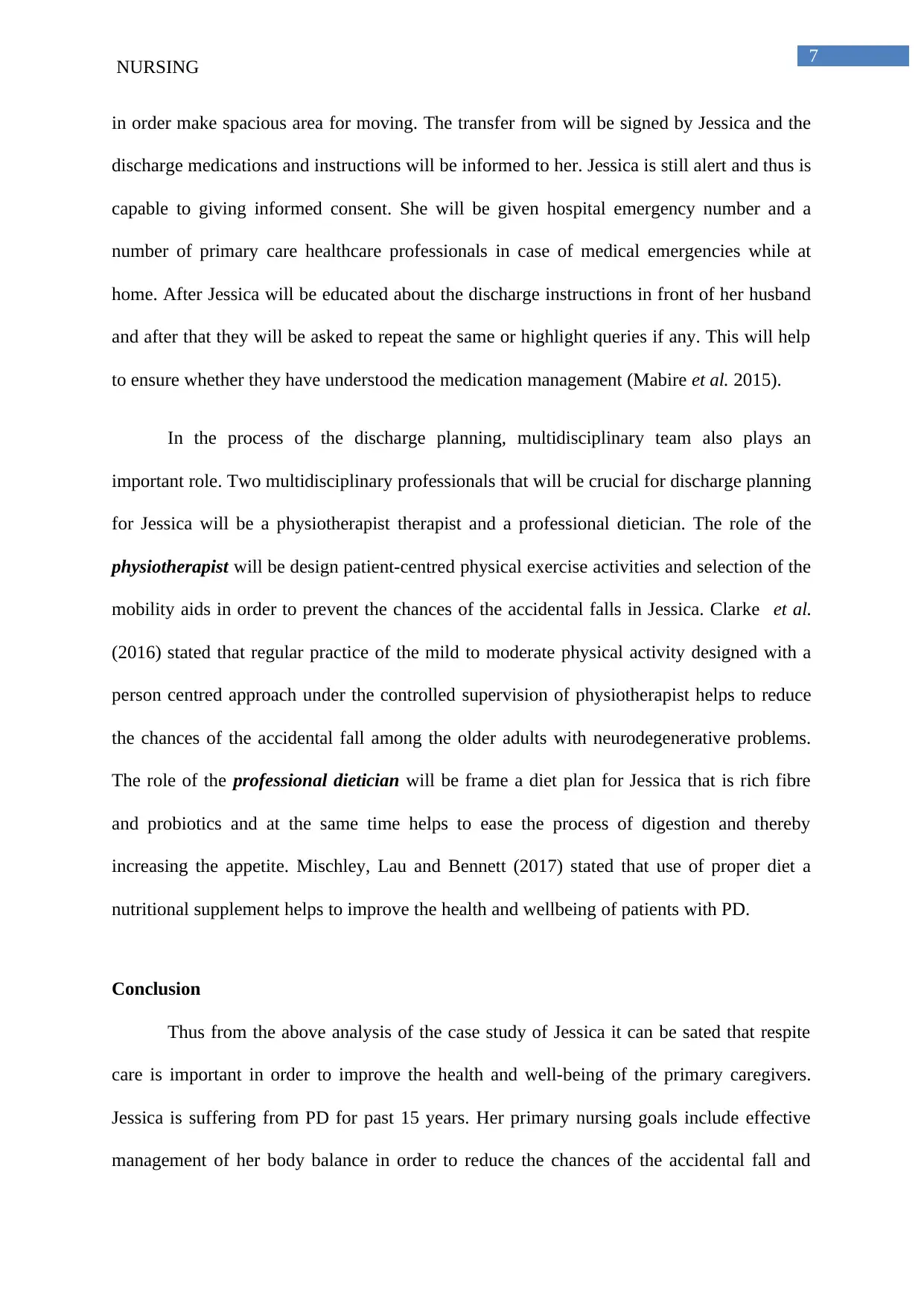
7
NURSING
in order make spacious area for moving. The transfer from will be signed by Jessica and the
discharge medications and instructions will be informed to her. Jessica is still alert and thus is
capable to giving informed consent. She will be given hospital emergency number and a
number of primary care healthcare professionals in case of medical emergencies while at
home. After Jessica will be educated about the discharge instructions in front of her husband
and after that they will be asked to repeat the same or highlight queries if any. This will help
to ensure whether they have understood the medication management (Mabire et al. 2015).
In the process of the discharge planning, multidisciplinary team also plays an
important role. Two multidisciplinary professionals that will be crucial for discharge planning
for Jessica will be a physiotherapist therapist and a professional dietician. The role of the
physiotherapist will be design patient-centred physical exercise activities and selection of the
mobility aids in order to prevent the chances of the accidental falls in Jessica. Clarke et al.
(2016) stated that regular practice of the mild to moderate physical activity designed with a
person centred approach under the controlled supervision of physiotherapist helps to reduce
the chances of the accidental fall among the older adults with neurodegenerative problems.
The role of the professional dietician will be frame a diet plan for Jessica that is rich fibre
and probiotics and at the same time helps to ease the process of digestion and thereby
increasing the appetite. Mischley, Lau and Bennett (2017) stated that use of proper diet a
nutritional supplement helps to improve the health and wellbeing of patients with PD.
Conclusion
Thus from the above analysis of the case study of Jessica it can be sated that respite
care is important in order to improve the health and well-being of the primary caregivers.
Jessica is suffering from PD for past 15 years. Her primary nursing goals include effective
management of her body balance in order to reduce the chances of the accidental fall and
NURSING
in order make spacious area for moving. The transfer from will be signed by Jessica and the
discharge medications and instructions will be informed to her. Jessica is still alert and thus is
capable to giving informed consent. She will be given hospital emergency number and a
number of primary care healthcare professionals in case of medical emergencies while at
home. After Jessica will be educated about the discharge instructions in front of her husband
and after that they will be asked to repeat the same or highlight queries if any. This will help
to ensure whether they have understood the medication management (Mabire et al. 2015).
In the process of the discharge planning, multidisciplinary team also plays an
important role. Two multidisciplinary professionals that will be crucial for discharge planning
for Jessica will be a physiotherapist therapist and a professional dietician. The role of the
physiotherapist will be design patient-centred physical exercise activities and selection of the
mobility aids in order to prevent the chances of the accidental falls in Jessica. Clarke et al.
(2016) stated that regular practice of the mild to moderate physical activity designed with a
person centred approach under the controlled supervision of physiotherapist helps to reduce
the chances of the accidental fall among the older adults with neurodegenerative problems.
The role of the professional dietician will be frame a diet plan for Jessica that is rich fibre
and probiotics and at the same time helps to ease the process of digestion and thereby
increasing the appetite. Mischley, Lau and Bennett (2017) stated that use of proper diet a
nutritional supplement helps to improve the health and wellbeing of patients with PD.
Conclusion
Thus from the above analysis of the case study of Jessica it can be sated that respite
care is important in order to improve the health and well-being of the primary caregivers.
Jessica is suffering from PD for past 15 years. Her primary nursing goals include effective
management of her body balance in order to reduce the chances of the accidental fall and
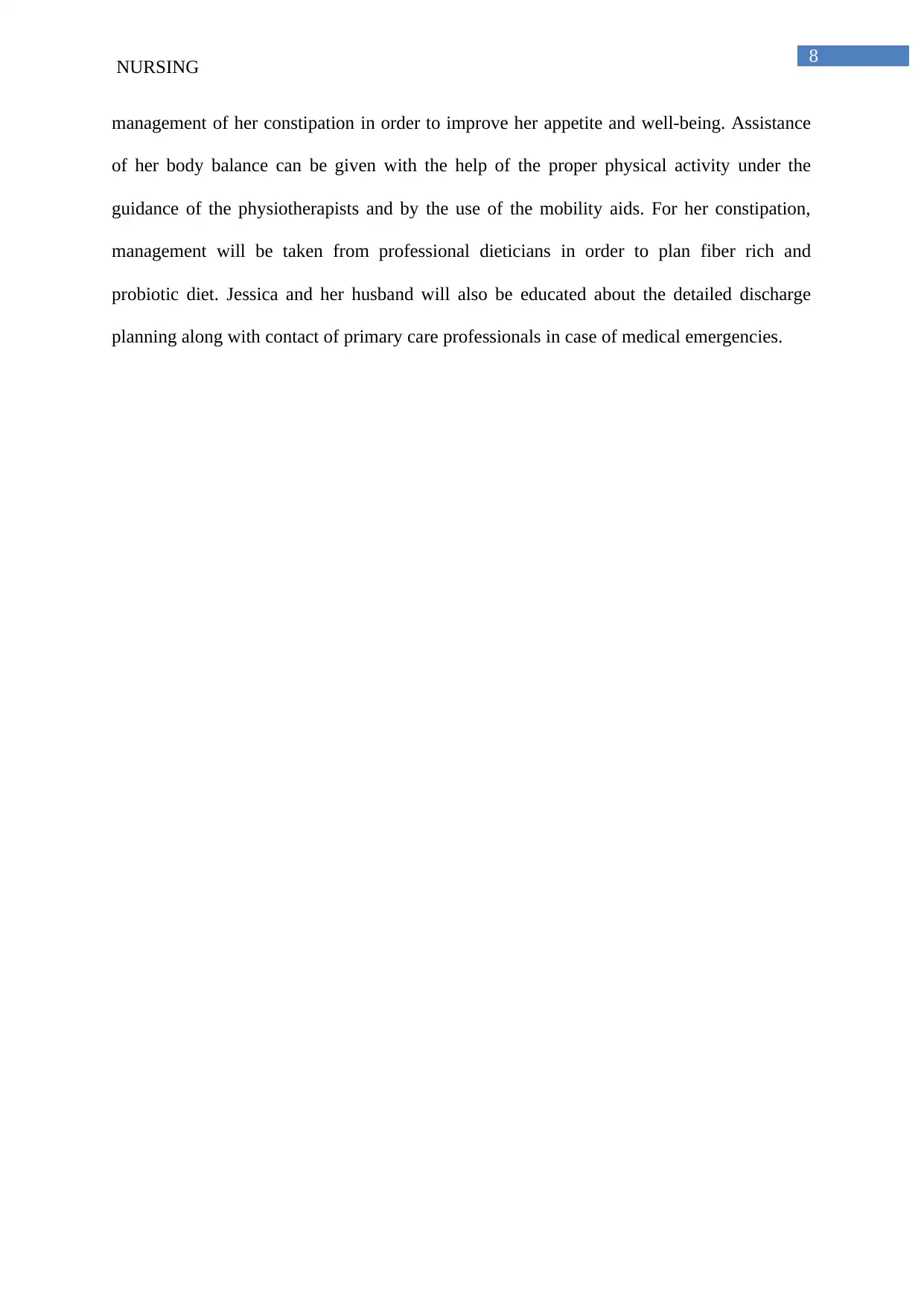
8
NURSING
management of her constipation in order to improve her appetite and well-being. Assistance
of her body balance can be given with the help of the proper physical activity under the
guidance of the physiotherapists and by the use of the mobility aids. For her constipation,
management will be taken from professional dieticians in order to plan fiber rich and
probiotic diet. Jessica and her husband will also be educated about the detailed discharge
planning along with contact of primary care professionals in case of medical emergencies.
NURSING
management of her constipation in order to improve her appetite and well-being. Assistance
of her body balance can be given with the help of the proper physical activity under the
guidance of the physiotherapists and by the use of the mobility aids. For her constipation,
management will be taken from professional dieticians in order to plan fiber rich and
probiotic diet. Jessica and her husband will also be educated about the detailed discharge
planning along with contact of primary care professionals in case of medical emergencies.
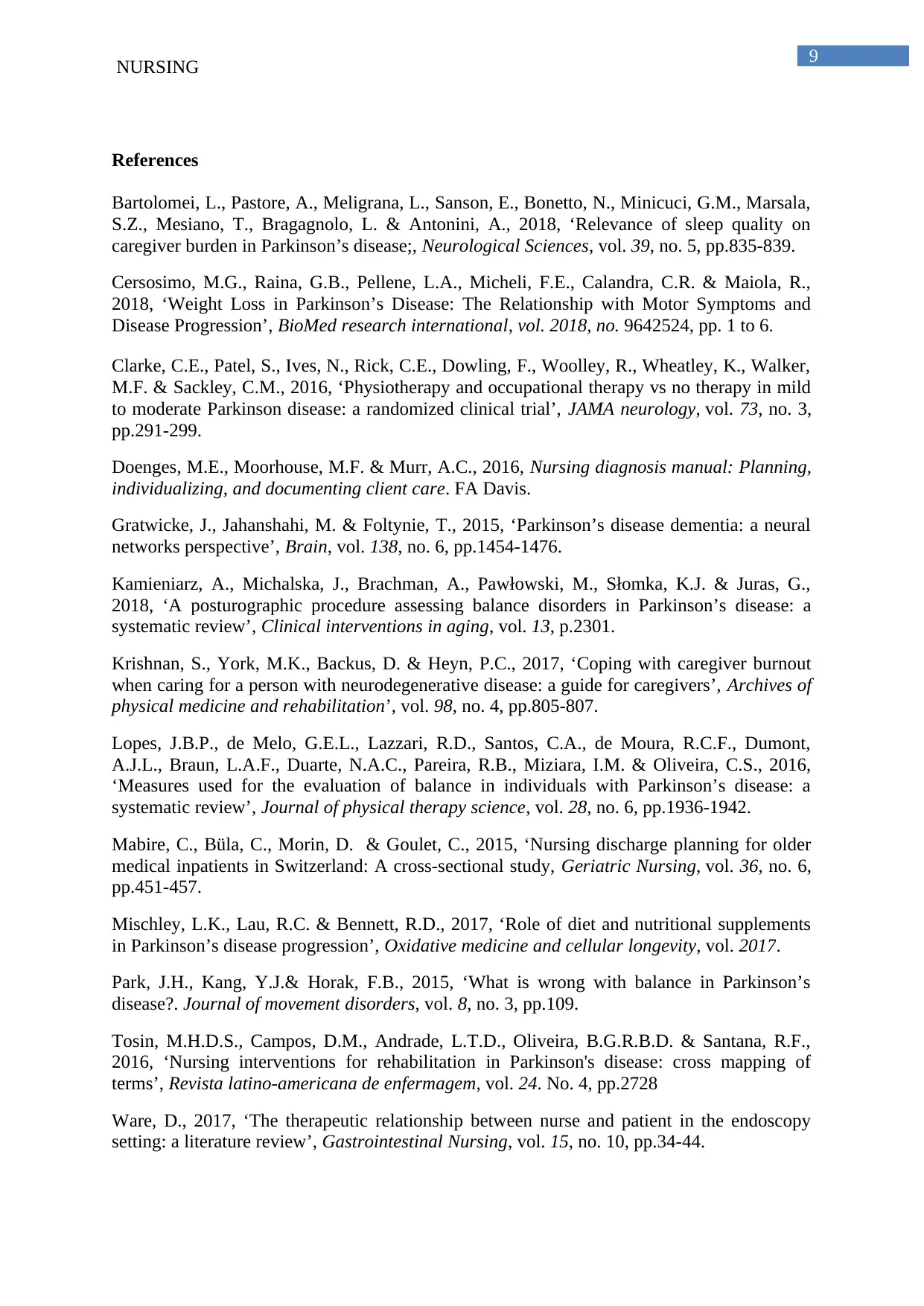
9
NURSING
References
Bartolomei, L., Pastore, A., Meligrana, L., Sanson, E., Bonetto, N., Minicuci, G.M., Marsala,
S.Z., Mesiano, T., Bragagnolo, L. & Antonini, A., 2018, ‘Relevance of sleep quality on
caregiver burden in Parkinson’s disease;, Neurological Sciences, vol. 39, no. 5, pp.835-839.
Cersosimo, M.G., Raina, G.B., Pellene, L.A., Micheli, F.E., Calandra, C.R. & Maiola, R.,
2018, ‘Weight Loss in Parkinson’s Disease: The Relationship with Motor Symptoms and
Disease Progression’, BioMed research international, vol. 2018, no. 9642524, pp. 1 to 6.
Clarke, C.E., Patel, S., Ives, N., Rick, C.E., Dowling, F., Woolley, R., Wheatley, K., Walker,
M.F. & Sackley, C.M., 2016, ‘Physiotherapy and occupational therapy vs no therapy in mild
to moderate Parkinson disease: a randomized clinical trial’, JAMA neurology, vol. 73, no. 3,
pp.291-299.
Doenges, M.E., Moorhouse, M.F. & Murr, A.C., 2016, Nursing diagnosis manual: Planning,
individualizing, and documenting client care. FA Davis.
Gratwicke, J., Jahanshahi, M. & Foltynie, T., 2015, ‘Parkinson’s disease dementia: a neural
networks perspective’, Brain, vol. 138, no. 6, pp.1454-1476.
Kamieniarz, A., Michalska, J., Brachman, A., Pawłowski, M., Słomka, K.J. & Juras, G.,
2018, ‘A posturographic procedure assessing balance disorders in Parkinson’s disease: a
systematic review’, Clinical interventions in aging, vol. 13, p.2301.
Krishnan, S., York, M.K., Backus, D. & Heyn, P.C., 2017, ‘Coping with caregiver burnout
when caring for a person with neurodegenerative disease: a guide for caregivers’, Archives of
physical medicine and rehabilitation’, vol. 98, no. 4, pp.805-807.
Lopes, J.B.P., de Melo, G.E.L., Lazzari, R.D., Santos, C.A., de Moura, R.C.F., Dumont,
A.J.L., Braun, L.A.F., Duarte, N.A.C., Pareira, R.B., Miziara, I.M. & Oliveira, C.S., 2016,
‘Measures used for the evaluation of balance in individuals with Parkinson’s disease: a
systematic review’, Journal of physical therapy science, vol. 28, no. 6, pp.1936-1942.
Mabire, C., Büla, C., Morin, D. & Goulet, C., 2015, ‘Nursing discharge planning for older
medical inpatients in Switzerland: A cross-sectional study, Geriatric Nursing, vol. 36, no. 6,
pp.451-457.
Mischley, L.K., Lau, R.C. & Bennett, R.D., 2017, ‘Role of diet and nutritional supplements
in Parkinson’s disease progression’, Oxidative medicine and cellular longevity, vol. 2017.
Park, J.H., Kang, Y.J.& Horak, F.B., 2015, ‘What is wrong with balance in Parkinson’s
disease?. Journal of movement disorders, vol. 8, no. 3, pp.109.
Tosin, M.H.D.S., Campos, D.M., Andrade, L.T.D., Oliveira, B.G.R.B.D. & Santana, R.F.,
2016, ‘Nursing interventions for rehabilitation in Parkinson's disease: cross mapping of
terms’, Revista latino-americana de enfermagem, vol. 24. No. 4, pp.2728
Ware, D., 2017, ‘The therapeutic relationship between nurse and patient in the endoscopy
setting: a literature review’, Gastrointestinal Nursing, vol. 15, no. 10, pp.34-44.
NURSING
References
Bartolomei, L., Pastore, A., Meligrana, L., Sanson, E., Bonetto, N., Minicuci, G.M., Marsala,
S.Z., Mesiano, T., Bragagnolo, L. & Antonini, A., 2018, ‘Relevance of sleep quality on
caregiver burden in Parkinson’s disease;, Neurological Sciences, vol. 39, no. 5, pp.835-839.
Cersosimo, M.G., Raina, G.B., Pellene, L.A., Micheli, F.E., Calandra, C.R. & Maiola, R.,
2018, ‘Weight Loss in Parkinson’s Disease: The Relationship with Motor Symptoms and
Disease Progression’, BioMed research international, vol. 2018, no. 9642524, pp. 1 to 6.
Clarke, C.E., Patel, S., Ives, N., Rick, C.E., Dowling, F., Woolley, R., Wheatley, K., Walker,
M.F. & Sackley, C.M., 2016, ‘Physiotherapy and occupational therapy vs no therapy in mild
to moderate Parkinson disease: a randomized clinical trial’, JAMA neurology, vol. 73, no. 3,
pp.291-299.
Doenges, M.E., Moorhouse, M.F. & Murr, A.C., 2016, Nursing diagnosis manual: Planning,
individualizing, and documenting client care. FA Davis.
Gratwicke, J., Jahanshahi, M. & Foltynie, T., 2015, ‘Parkinson’s disease dementia: a neural
networks perspective’, Brain, vol. 138, no. 6, pp.1454-1476.
Kamieniarz, A., Michalska, J., Brachman, A., Pawłowski, M., Słomka, K.J. & Juras, G.,
2018, ‘A posturographic procedure assessing balance disorders in Parkinson’s disease: a
systematic review’, Clinical interventions in aging, vol. 13, p.2301.
Krishnan, S., York, M.K., Backus, D. & Heyn, P.C., 2017, ‘Coping with caregiver burnout
when caring for a person with neurodegenerative disease: a guide for caregivers’, Archives of
physical medicine and rehabilitation’, vol. 98, no. 4, pp.805-807.
Lopes, J.B.P., de Melo, G.E.L., Lazzari, R.D., Santos, C.A., de Moura, R.C.F., Dumont,
A.J.L., Braun, L.A.F., Duarte, N.A.C., Pareira, R.B., Miziara, I.M. & Oliveira, C.S., 2016,
‘Measures used for the evaluation of balance in individuals with Parkinson’s disease: a
systematic review’, Journal of physical therapy science, vol. 28, no. 6, pp.1936-1942.
Mabire, C., Büla, C., Morin, D. & Goulet, C., 2015, ‘Nursing discharge planning for older
medical inpatients in Switzerland: A cross-sectional study, Geriatric Nursing, vol. 36, no. 6,
pp.451-457.
Mischley, L.K., Lau, R.C. & Bennett, R.D., 2017, ‘Role of diet and nutritional supplements
in Parkinson’s disease progression’, Oxidative medicine and cellular longevity, vol. 2017.
Park, J.H., Kang, Y.J.& Horak, F.B., 2015, ‘What is wrong with balance in Parkinson’s
disease?. Journal of movement disorders, vol. 8, no. 3, pp.109.
Tosin, M.H.D.S., Campos, D.M., Andrade, L.T.D., Oliveira, B.G.R.B.D. & Santana, R.F.,
2016, ‘Nursing interventions for rehabilitation in Parkinson's disease: cross mapping of
terms’, Revista latino-americana de enfermagem, vol. 24. No. 4, pp.2728
Ware, D., 2017, ‘The therapeutic relationship between nurse and patient in the endoscopy
setting: a literature review’, Gastrointestinal Nursing, vol. 15, no. 10, pp.34-44.
Secure Best Marks with AI Grader
Need help grading? Try our AI Grader for instant feedback on your assignments.
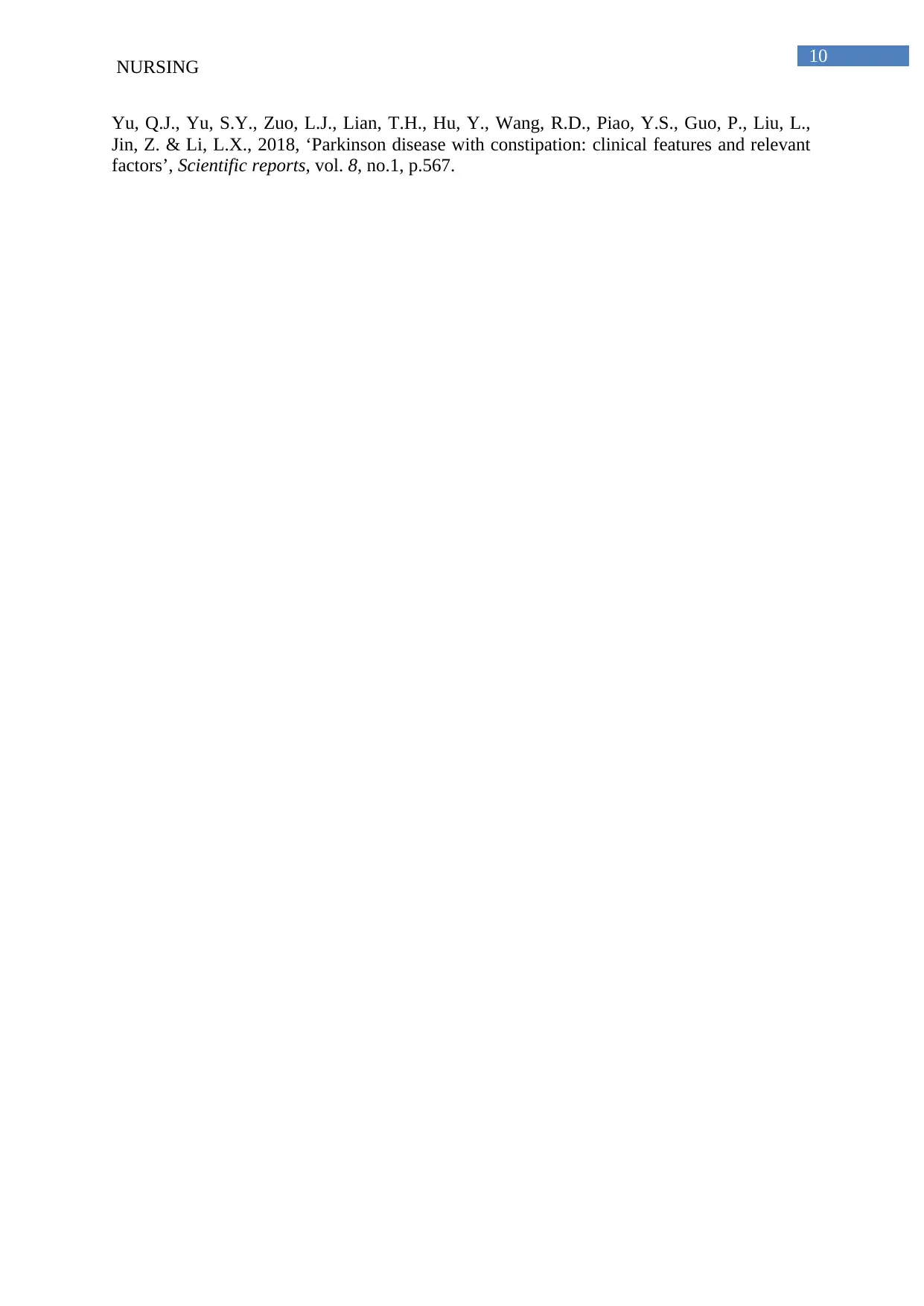
10
NURSING
Yu, Q.J., Yu, S.Y., Zuo, L.J., Lian, T.H., Hu, Y., Wang, R.D., Piao, Y.S., Guo, P., Liu, L.,
Jin, Z. & Li, L.X., 2018, ‘Parkinson disease with constipation: clinical features and relevant
factors’, Scientific reports, vol. 8, no.1, p.567.
NURSING
Yu, Q.J., Yu, S.Y., Zuo, L.J., Lian, T.H., Hu, Y., Wang, R.D., Piao, Y.S., Guo, P., Liu, L.,
Jin, Z. & Li, L.X., 2018, ‘Parkinson disease with constipation: clinical features and relevant
factors’, Scientific reports, vol. 8, no.1, p.567.
1 out of 11
Related Documents
Your All-in-One AI-Powered Toolkit for Academic Success.
+13062052269
info@desklib.com
Available 24*7 on WhatsApp / Email
![[object Object]](/_next/static/media/star-bottom.7253800d.svg)
Unlock your academic potential
© 2024 | Zucol Services PVT LTD | All rights reserved.





